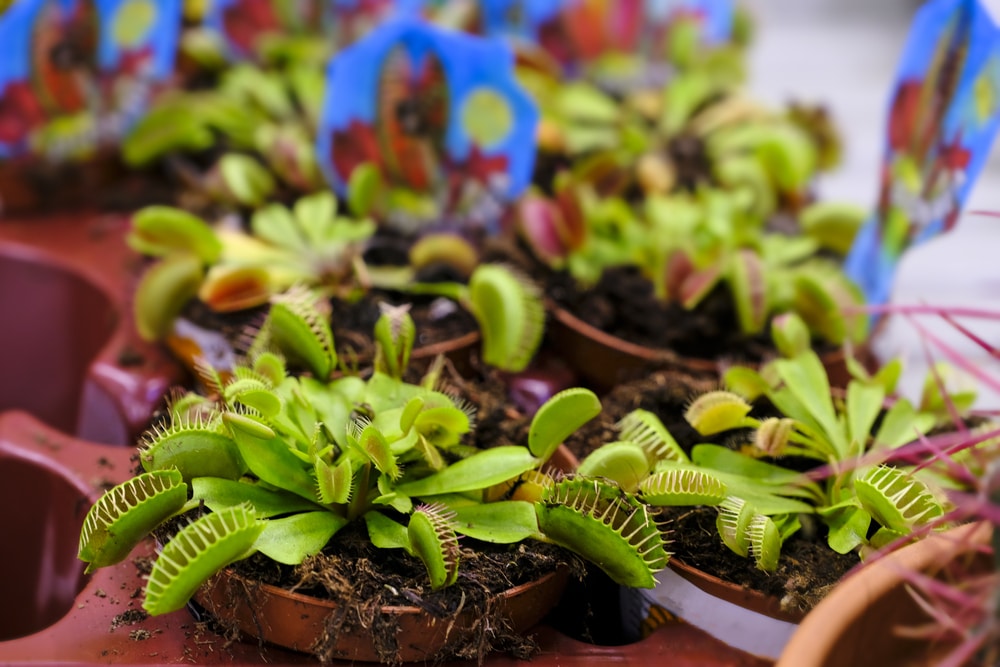Carnivorous plants are truly an evolutionary oddity, and for good reason. They have existed for over 70 million years, slowly evolving to adapt to nutrient-poor soils by catching live prey full of the nutrients they need to survive.
Now, these plants still exist in albeit dwindling habitats, but they also live somewhere else: in our homes. Hobbyists often collect a variety of carnivorous plant species to keep in specialized climates or simply in kitchen windowsills. But if these plants are so accustomed to living in the wild and catching their own prey, how do they survive in windowsill planters?
The truth is that these types of plants still need to be fed on a regular basis, whether it be feeding live prey, rehydrating meals from a jar, or even applying the right kind of fertilizer. We’ll go over a few of the most common types of carnivorous plants and how to feed them, so you can enjoy keeping your own piece of evolutionary history alive.
Common Types of Carnivorous Plant Food
While it can be tricky to replicate the variety of natural prey a particular species is accustomed to in the wild, there are plenty of worthy substitutes that are more than fit to replace the natural diet of your carnivorous plant. The following are just a few examples of the types of food that carnivorous plants can thrive on in captivity.
- Live Prey
- Dehydrated Food
- Fertilizers
Keep reading below for complete step-by-step instruction for each type of carnivorous plant food!
Live Prey
With limited access to unsuspecting insects, carnivorous plants need a little help procuring their meals. Some insects make particularly nutrient-rich foods, while others are more of a snack for your hungry carnivore. Check your local pet stores or online to find fresh food.
Mealworms
As absolutely gross as this sounds, mealworms make the perfect meal for carnivorous plants that have a large capacity to eat bigger bugs. If you keep reptiles, you likely have these on hand; if not, they can easily be found at most pet stores and even online locally. Mealworms are very nutritionally complete, and offer the right amount of nutrients for most species.
House flies and fungus gnats
Some folks choose to keep carnivorous plants as natural house fly population control, but there are a few caveats here. Fungus gnats and fruit flies, both miniscule in size, may be able to feed a few species of sundews or butterworts, but typically aren’t enough to sustain bigger plants.
Crickets
Another delicacy typical to pet stores and reptile shops, crickets are perfect for larger types of carnivorous plants. Although they can be difficult to handle, they can easily fit inside a large trap or pitcher. These bugs are also a very nutritious meal, but they’re not a great option for smaller types of carnivorous plants.
Dehydrated Food
Dehydrated food is exactly what it sounds like: freeze-dried sources of nutrients that make a great alternative to live insects in your house. If feeding your carnivorous plants wriggling worms just isn’t in the cards for you, these options can work instead.
Bloodworms
Small enough for the carnivores with tiny traps and tendrils, bloodworms are perfect for feeding carnivorous plants that don’t have specialized systems for catching large prey. They typically come dehydrated in a jar from the pet store, so they’ll need to be rehydrated before becoming your plant’s next meal. Bloodworms alone are enough to sustain certain species.
Fish food
Fish foot pellets and flakes are popular options for those who would rather not touch bugs, with or without tweezers. Much like dehydrated bloodworms, though, fish food of any kind will need to be rehydrated before being fed to your carnivorous plants.
Fertilizers
Fertilizers can be either beneficial or extremely taxing to most carnivorous plants. However, when used properly and in very minute volumes, they can be a great source of nutrients. Fertilizers need to be , but they’re not typically applied to the growing medium like other plants.
Osmocote
This particular fertilizer is called “Osmocote Flower and Vegetable”, and is considered within the carnivorous plant community to be a safe pellet-based alternative to bug-based foods for some carnivorous plants, especially those with pitchers.
MaxSea
Another great option for fertilizer is MaxSea, which can be applied to carnivorous plants that rely on sticky surfaces to catch their prey. Heavily diluted, this fertilizer is a complete meal for most plants of the type.
How Often to Feed Carnivorous Plants
The amount of food a plant receives will directly impact its ability to grow. The same goes for carnivorous plants. If a carnivorous plant doesn’t receive enough food, its growth will be stunted; the plant can’t make new traps, and it will eventually die off.
However, each type of plant has different needs. Venus flytraps, for example, need to be fed at least once every week to two weeks. A good rule of thumb is to be sure at least one trap is always workinig on food.
For pitcher plants, the norm looks a little different. These types of plants digest food differently, and it takes them longer to digest a meal than an average venus fytrap. For this reason, pitcher plants should only be fed once every two to three weeks, or when you notice that a pitcher is done digesting its last meal.
Sundews, on the other hand, are very peckish eaters and don’t require frequent feedings. Younger sundews, in their early growth stages, need food once a month or so, whereas mature sundews can be fed just once every three months. The same can be said for butterworts, though they don’t require any feeding at all during their annual dormancy period.
How to Feed Carnivorous Plants
Finding the right food means nothing if you over or underfeed your carnivorous plants. That’s why it’s so important to know how much food your plants need, and how often. Read on to learn how to feed some of the most commonly kept carnivorous plants.
How to Feed Venus Fly Traps
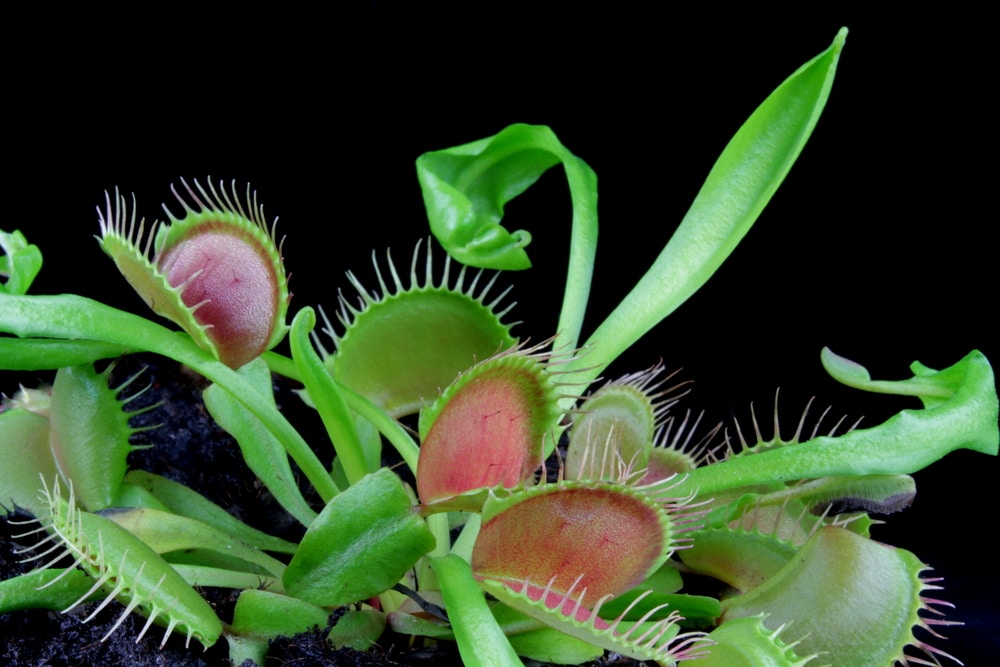
Perhaps the most common type of carnivorous houseplant is the venus flytrap. Frequently sold in little plastic containers at any store that also sells houseplants, venus flytraps are usually not well taken care of before they make it into your home.
That being said, most venus flytraps will need some care once you bring them home. Check to see if there are any shut traps that still look healthy. Finding a trap like this can mean that either the plant recently caught a meal, or someone stuck a curious finger inside.
Venus flytraps can eat a variety of foods, including live prey and dehydrated foods. Due to the nature of the flytrap design, though, fertilizer won’t work well for this type of carnivorous plant. Be sure to rehydrate any dehydrated food (including fish food) before feeding.
If there is evidence that your venus flytrap recently ate, wait a few weeks before feeding again. Otherwise, follow these steps to get your plant some much-needed nutrient.
Step 1: Prepare the food
Whether your’re using dehydrated food or live prey, be sure to get it ready for feeding. Food needs to be soft enough to digest, since the plant relies entirely on enzymes to break down food that it captures.
Step 2: Apply food to the traps
Using a pair of clean, sanitized tweezers, gently lay the food inside of the trap so that none of it hangs out of the sides. Too much food in a trap will overwhelm the plant, and it won’t be able to digest its meal. Fill the trap just enough to cover the inner crease.
Step 3: Stimulate the traps
If the traps don’t automatically close, don’t worry; use the tweezers to “tickle” the hairs inside the trap that stick up at least three times to trigger the trap to close. Then, carefully apply a tiny amount of pressure to the outside of the trap in a pulsating movement to simulate an insect trying to escape. This helps to release the enzymes needed for digestion.
Step 4: Repeat (if necessary)
The more traps your plant has, the more food it will need to survive. Smaller plants, with less than ten traps, need only one trap to catch food; however, larger plants with many traps may need two or three traps to be fed. Be careful not to overfeed; one or two traps per feeding will suffice.
How to Feed Sundews
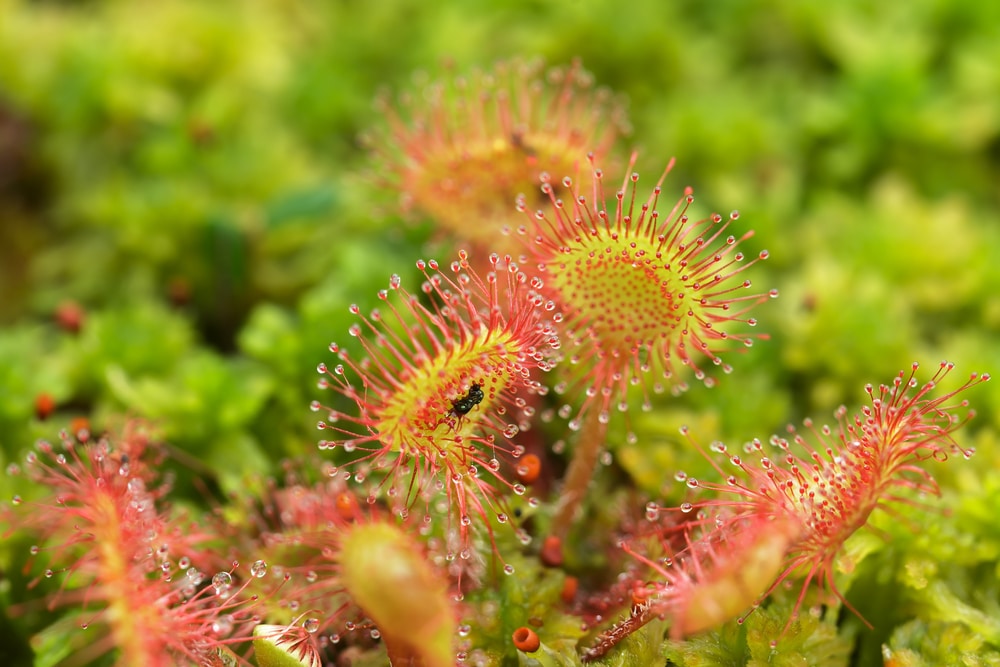
While sundew plants don’t carry the same snapping appeal that venus flytraps do when feeding, the process is still super interesting to watch. Once a leaf traps prey (or fertilizer) in the sticky droplets on a leaf, it will curl inward, trapping whatever was caught inside. Once this process begins, the plant will use enzymes to break down the nutrients into usable fuel.
Sundews generally eat smaller insects such as gnats, flies, and mosquitoes, so sticking with smaller quantities of food for each leaf is essential. Suitable foods include dead or dehydrated insects, fish food flakes or pellets, and MaxSea fertilizer, though the latter should never be applied to the soil or substrate. Here’s how to properly feed your sundew.
Step 1: Prepare the food
For dehydrated foods, simply add a touch of distilled water to a container and add the dehydrated meal before feeding. To use MaxSea fertilizer instead, mix ¼ tsp fertilizer with one gallon of distilled water and mix thoroughly.
Step 2: Apply the food
Using a pipette for fertilizer or tweezers for other food, gently place a small amount of food near the top of each of the largest leaves. Generally, a few drops of diluted fertilizer solution or a couple flakes or pellets of fish food will suffice. For rehydrated foods, aim for one or two small insects.
Step 3: Watch the leaves
To get the right amount of food correct each time you feed, watch the leaves over the next few hours to see which leaves seemed to curl with no issues and which were slow to curl. This is a great way to learn how much food to food each plant, and how long it can take for them to digest their food.
How to Feed Pitcher Plants
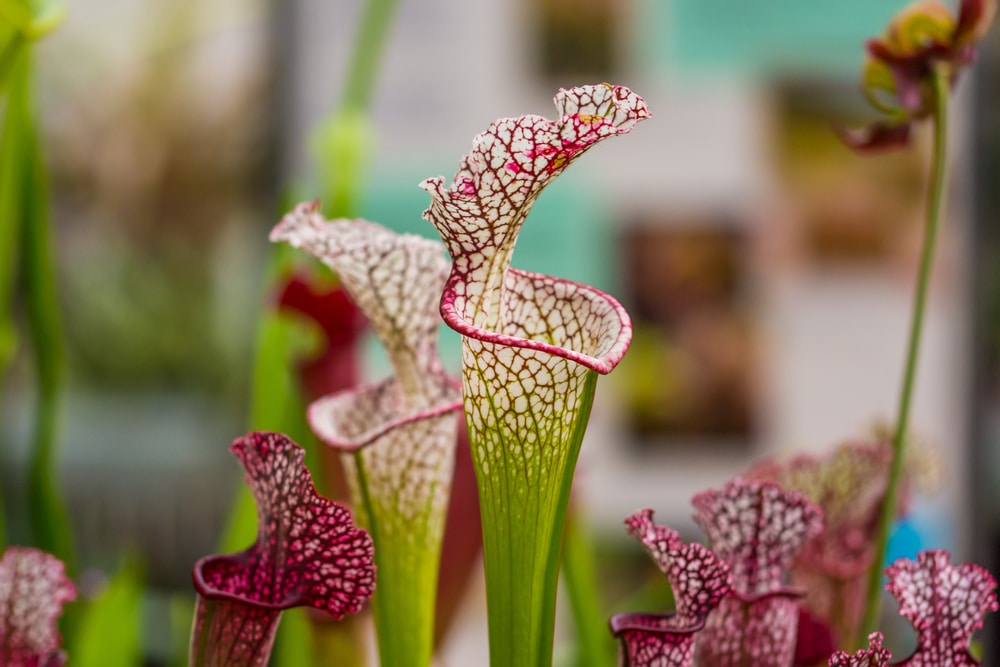
When left out in the open, most pitcher plants won’t need to be manually fed very often. Common house bugs, like flies and gnats, find pitchers to be irresistible places to hide. If you often find your pitchers to be a full of floating bugs, chances are they won’t need much from you.
On the contrary, pitcher plants that are kept in terrariums or other enclosures should be fed every two to three weeks. They can digest rehydrated foods, live prey, and fertilizers, which are fed into the pitcher; not into the soil. Here’s how to do it.
Step 1: Prepare the food
Osmocote is the most popular type of food on the market for pitcher plants due to convenience, but if you choose to use dehydrated food, be sure to rehydrate it using a small amount of distilled water first. To use MaxSea, simply mix ¼ tsp into one gallon of distilled water.
Step 2: Apply the food
Just two pellets of Osmocote fertilizer or a few drops of diluted MaxSea fertilizer is plenty of food. If you’re using rehydrated insects or fish food, go for two to three insects per pitcher or a few pellets or fish flakes per pitcher. Only feed one or two pitchers, depending on how many your plant has.
Step 3: Add water, if needed
Sometimes, the fluids inside pitcher plants can evaporate. In this case, you can add a teaspoon or so of distilled water only to help the plant create the enzymes it needs to break the nutrients down into food. Pitchers that have fluid in them already don’t need this same treatment.
How to Feed Butterworts
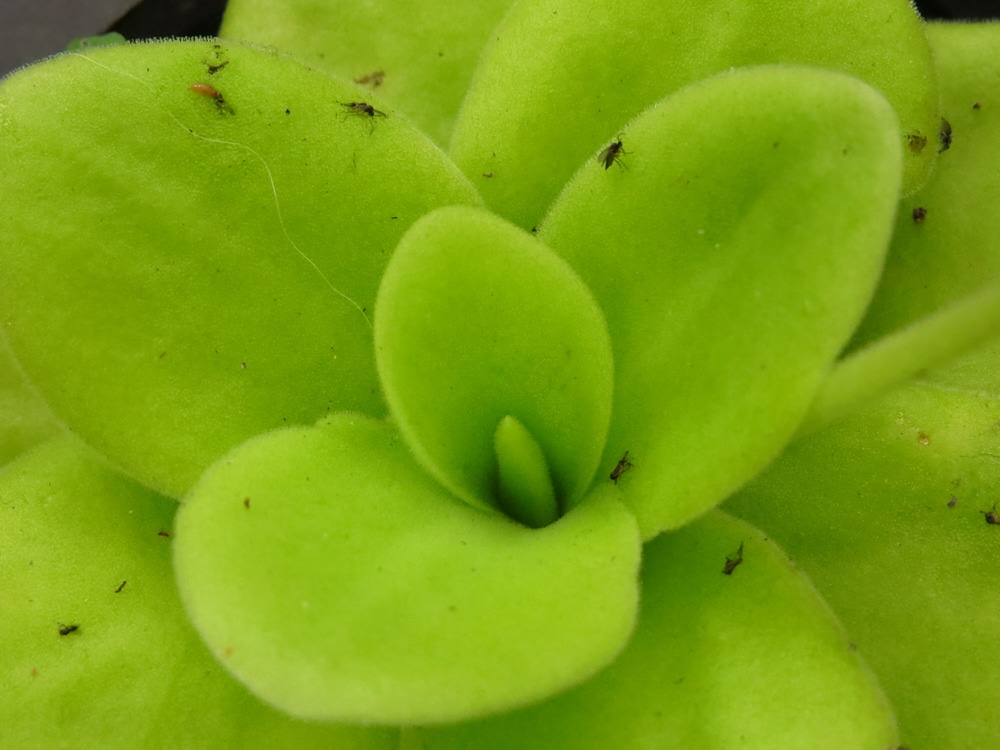
These cute little succulent-esque plants are restricted to very small food sources. Much like sundew plants, butterworts typically prefer fungus gnats, fruit flies, mosquitoes, and other miniscule flying bugs that often invade houses and indoor gardens.
During its growth stages, butterworts are fairly good at catching their own meals, unless you keep them in an enclosure. Once a year, they’ll go into dormancy, wherein they will lose most of their leaves and revert to a small, succulent-type plant that doesn’t need any food.
Step 1: Prepare the food
Butterworts can typically handle dried foods, so long as they’e ground up rather fine. Fish flakes and pellets or dried bloodworms are best for this type of plant, but you can also use a few drops or a spritz of diluted MaxSea fertilizer; just add ¼ tsp to a gallon of distilled water to dilute.
Step 2: Apply the food
To feed your butterwort dehydrated foods, apply the crushed or powdered bits near the end of a leaf. For fertilizer, simply spray a fine mist over the plant until at least a few small droplets settle on the outer leaves; avoid getting food inside the crown. Try to feed ata least half of the plant’s leaves for best results, since they go an extended period without food each year.
Step 3: Remove spent leaves
Since butterworts are dependent on their sticky leaves, it’s important to remove the old, dried up leaves to prevent rot and allow the plant more room to grow new leaves. Wait until a leaf is dried up entirely before removing, so the plant has a chance to extract all of the nutrients from it before you remove it.
The Easy Way to Feed Carnivorous Plants
If you have carnivorous plants in your space, there’s a really good chance you have other plants, as well. Fungus gnats often hang out in houseplant soil, slowly but surely wreaking havoc where our eyes can’t reach.
Similarly, fruit flies can breed in your home, particularly in kitchen sinks, garbage disposals, and even in your pantry. A few house flies might sneak in during the warmer months, as well.If it sounds like we’re suggesting your home has bugs in it, that’s because it’s very likely that you do, whether you notice them or not. That’s where carnivorous plants come in.
If you have an active pest problem involving flying insects, placing carnivorous plants near the problem can help. For example, if you have fungus gnats, place your carnivores near the plants that are msot affected; they’ll love it.
You can also put a few carnivorous plants in your kitchen or other problem areas, given they have enough light. These plants evolved to catch live prey in their natural environments, and they can do the same in your space, too.
Carnivorous plants are fun and rewarding to keep, and incredibly easy once you get the hang of care and feeding. We should warn you, though; collecting them can be addicting!
